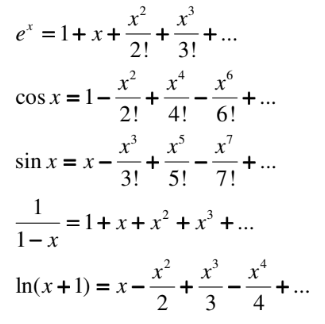AP Calculus BC Must Knows!
L’Hopital’s Rule:
In plain English: if a limit results in an indeterminant form, the limit is equal to the derivative of both the numerator and denominator.
If f(a)/g(a) = 0/0 or =∞/∞, then: lim x→a f(x)/g(x) = lim x→a f’(x)/g’(x)
Average Rate of Change (slope of the secant line)
In plain English: The average rate of change is similar to the basic Δy/Δx*, but instead of y values in the numerator, there are slope values, and x values are on the bottom.*
If the points (a, f(a)) and (b, f(b)) are on the graph of f(x) the average rate of change of f(x) on the interval [a,b] is: [f(b) - f(a)]/[b-a]
Limit Definition of the Derivative (slope of the tangent line)
In plain English: If you take two points, and move them so close together you are almost (but not quite) adding 0, you create a tangent line and have therefore found the instantaneous rate of change.
f’(x) = lim h→0 [f(x+h) - f(x)]/h
Common derivatives YOU MUST KNOW !!!!!!!!!!
| ==Original function== | ==Derivative== |
|---|---|
| x^n | n * x^(n-1) |
| sin x | cos x |
| cos x | -sin x |
| tan x | (sec x)^2 |
| cot x | -(csc x)^2 |
| sec x | tan x * sec x |
| csc x | -cot x * csc x |
| ln x | 1/x |
| e^x | e^x |
| loga(x) | 1 / [x * ln a] |
| a^x | a^x * ln a |
Properties of Log and Ln:
ln 1 = 0
ln e^a = a
e^ln x = x
ln x^n = n ln x
ln(ab) = ln a + ln b
ln(a/b) = ln a - ln b
Differentiation rules:
CHAIN RULE: d/dx [f(u)] = f’(u) du / dx
PRODUCT RULE: d/dx (uv) = (u)(dv/dx) + (v)(du/dx)
QUOTIENT RULE: d/dx(u/v) = [(v)(du/dx) - (u)(dv/dx)'] / v^2
Mean Value Theorem (MVT):
In plain English: If f(x) is made up of one going line, and there exists two y values in two coordinates (say 3 and 5), there has to be an x value where the y value is in between 3 and 5 (like 4) because the lie does not “jump” or have holes.
If the function f(x) is continuous on [a,b] and the first derivative exists on the interval (a,b) then there exists a number x=c on (a,b) such that f’(c) = [f(b)-f(a)]/[b-a].
Curve Sketching and Analysis:
To find a local minimum: f’(x) changes from - to +.
To find a local maximum: f’(x) changes from + to -.
To find an absolute max/min: compile all the local points and plug back into the original function.
To find a point of inflection: f’’(x) goes from + to - or - to +.
- \
- f’’(x) is concave up
- \
- f’’(x) is concave down
The Fundamental Theorem of Calculus:
a to b∫f(x)dx = F(b) - F(a) where F’(x) = f(x)
The 2nd Fundamental Theorem of Calculus:
In plain English: The derivative of an integral where one of the end points is a function (A) is that function plugged directly into the function in the integral (B) multiplied by the derivative of the end point function (A’)
d/dx (# to g(x)) ∫f(x)dx = f(g(x)) * g’(x)
Average Value:
**If the function f(x) is continuous on [a.b] and the first derivative exists on the interval (a,b), then there exists a number x=c on (a,b) such that the average value is f(c) = 1/[b-a] ***∫f(x)dx ***note the integral is from a to b
Euler’s Method: Create the table as shown. Fill out all information to find your value. Note that Δx is the “step” you are talking, and dy/dx is the slope.
| x value | y value | dy/dx | Δx | dy/dx * Δx |
|---|
Logistics Curves:
P(t) = L / [1+ Ce^(-Lk)t] where L is carrying capacity.
- maximum growth rate occures when P = 1/2 L
dP/dt = kP(L - P) = (Lk)(P)(1-[P/L])
Integrals YOU MUST KNOW !!!!!!!!!!!!!!!
| ∫kf(u) du | k∫f(u)du |
|---|---|
| ∫du | u + C |
| ∫1/[(1-x^2)^1/2] dx | inverse sin |
| ∫ -1/[1-x^2)^1/2] dx | inverse cos |
| ∫1/(1+x^2) dx | inverse tan |
| ∫-1/(1+x^2) | inverse cot |
| ∫1/[|x|(x^2-1)^1/2] | inverse sec |
| ∫-1/[|x|(x^2-1)^1/2] | inverse csc |
Integration by Parts:
∫u dv = uv - ∫v du
USE LIPET TO DETERMINE U:
- Logs
- Inverse trig
- Polynomial functions
- Exponential functions
- Trig
Arc Length:
For a function f(x): L = ∫[(1+f’(x)^2]^1/2 dx
For a polar graph r(θ): L = [(r(θ)^2+(r’(θ)^2]^1/2 dθ
Lagrange Error Bound:

Distance, velocity, acceleration
Velocity = d/dt (position)
Acceleration = d/dt (velocity)
Velocity vector =
Speed = |v(t)| = [(x’)^2+(y’)^2]^1/2 <-- this is Pythagorean theorem !!!!!
Distance traveled = ∫speed
Polar curves:
For a polar curve r(θ), the area in one part is 0.5∫r(θ)^2 dθ.
dy/dx = dy/dθ * dθ/dx = d/dθ [r(θ)sinθ] / d/dθ [r(θ)cosθ]
Remember that x = rcosθ and y=rsinθ
Ratio Test:
The series of a(n) converges if lim n→infinity |a(n+1)/a(n)| < 1. CHECK ENDPOINTS!
Alternating Series Error Bound:
The maximum error of a convergent alternating series is the next term of the sequence.
P-Series:
| 1/p^n | n = 1, n < 1 | n > 1 |
|---|---|---|
| from 0 to infinity | diverges | converges |
Volume
Disk method: V = π∫[R(x)]^2 dx
Washer method: V = π∫[R(x)^2 - r(x)^2] dx
Known cross sections
V = ∫A(x) dx or ∫A(y) dy
Taylor series:
f(x) is about f(c) + f’c(x-c) + f’’(c) 8 (x-c)^2 / 2! _
